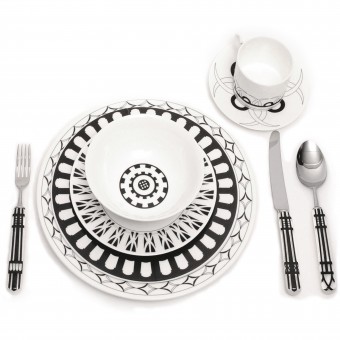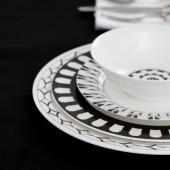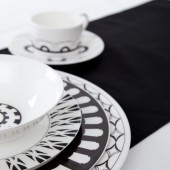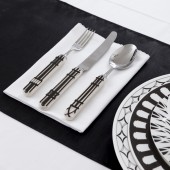Nouveau Tudor Dinnerware by Khadine Khan-Parkinson |
Home > Winners > #42634 |
 |
|
||||
| DESIGN DETAILS | |||||
| DESIGN NAME: Nouveau Tudor PRIMARY FUNCTION: Dinnerware INSPIRATION: The inspiration for this project began by looking at decorative exterior architectural elements and how they could be applied to interior functional objects. Various decorative motifs from Europe to the Caribbean were analysed and then I selected specific iconic buildings that embodied each architectural style. For the Nouveau Tudor design I selected the Liberty of London building and developed the pattern based on its facade. UNIQUE PROPERTIES / PROJECT DESCRIPTION: A modern monochrome set inspired by elements of Tudor architecture. The traditional black and white timber framed buildings are translated into a bold and unique graphic pattern for each piece of the service. Like the buildings, the set when displayed together, combine the individual patterns into a dramatic and dynamic display. The porcelain handled flatware was 3D printed to create a relief that mimics the timber frames embedded in plaster. Together they create a stunning place setting. OPERATION / FLOW / INTERACTION: For maximum impact the place setting works best when all the pieces are layered on top of the other from largest to smallest instead of being set in a formal dining layout. The porcelain-handled flatware is well balanced and fit comfortably in the hand. The design works well in both period and contemporary interiors and monochrome colour scheme makes it a timeless classic. PROJECT DURATION AND LOCATION: The project started in 2013 in Havering College, Romford and finished in May 2015. It was first exhibited in New Designers June 2014 in Islington, London. |
PRODUCTION / REALIZATION TECHNOLOGY: This collection was created by combining new digital desktop manufacturing technologies and traditional ceramic techniques. The porcelain handled cutlery was slip cast in moulds created from 3D printed prototypes while the dinnerware patterns were either digitally created, then screen printed by hand and applied to the white ware. SPECIFICATIONS / TECHNICAL PROPERTIES: Dinner Plate, Diameter 300mm Salad Plate, Diameter 250mm Bread Plate, Diameter 200mm Bowl, Diameter 150mm Saucer, Diameter 200mm Cup, Diamter 840mm, Height 580mm Flatware, Length 260mm, Width 20mm, Height 160mm TAGS: tableware, architecture, dinnerware, Tudor, 3D printing, ceramics, dinnerware, flatware, cutlery, Castara, Khadine RESEARCH ABSTRACT: This project set out to determine if desktop manufacturing technologies, like 3D printing, combined with traditional making techniques, like slip-casting, would allow for sustainable, small batch production of design-led home accessories. Combinations of old and new making techniques were tried, (e.g. laser cutting with hand building clay) together with various material combinations like glass and metal. The implications of a successful outcome are far reaching in re-creating sustainable and profitable cottage industries for designers by utilizing crafts with digital technology. CHALLENGE: One challenge was melding the precision of digital production with the unpredictability of traditional methods and materials. Another was making a repeatable process to standardize the product. It was important to carry through the essence of the project of blending traditional and modern with the design itself. Therefore the pattern of the Tudor facades was not a literal depiction but distilled into bold geometrics. Striking a balance between the old and the new so that they both show through in the final product in terms of materials, techniques and aesthetics was the greatest challenge. ADDED DATE: 2015-09-18 09:27:24 TEAM MEMBERS (1) : IMAGE CREDITS: Image #1: Photographer Khadine Khan-Parkinson, 2014 Optional Image #1: Photographer Yeshen Venema, 2014. Optional Image #2: Photographer Yeshen Venema, 2014. Optional Image #3: Photographer Yeshen Venema, 2014. Optional Image #4: Photographer Yeshen Venema, 2014. PATENTS/COPYRIGHTS: Copyrights belong to Khadine Khan-Parkinson, 2014 |
||||
| Visit the following page to learn more: http://www.castaradesigns.com | |||||
| AWARD DETAILS | |
 |
Nouveau Tudor Dinnerware by Khadine Khan-Parkinson is Winner in Bakeware, Tableware, Drinkware and Cookware Design Category, 2015 - 2016.· Press Members: Login or Register to request an exclusive interview with Khadine Khan-Parkinson. · Click here to register inorder to view the profile and other works by Khadine Khan-Parkinson. |
| SOCIAL |
| + Add to Likes / Favorites | Send to My Email | Comment | Testimonials | View Press-Release | Press Kit |







